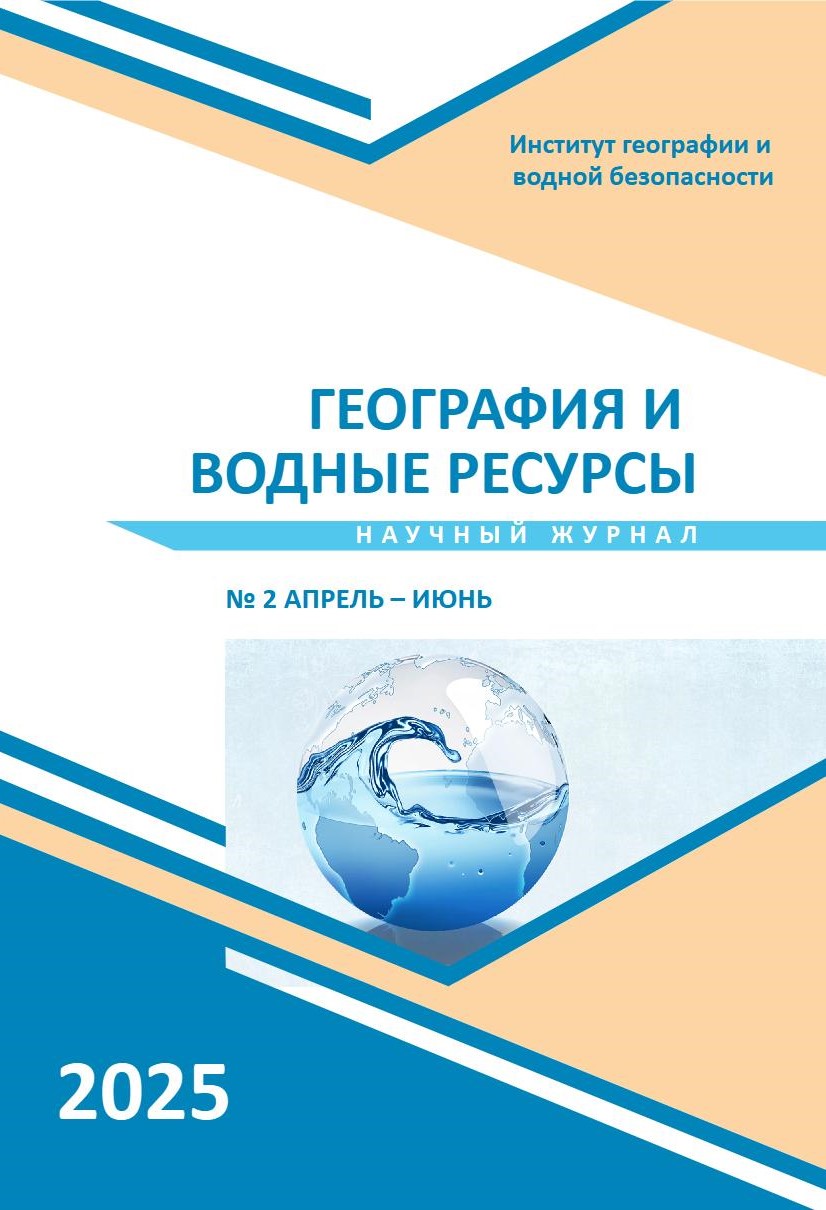PHYSICAL AND GEOGRAPHICAL FEATURES OF KAZAKHSTAN AND THEIR REFLECTION IN TURKIC TOPONYMS
Main Article Content
Abstract
This article examines Turkic toponyms as indicators that reflect the physical and geographical features, as well as landscape changes, across the territory of Kazakhstan. The meanings of various categories of toponyms, such as oronyms, hydronyms, limnonyms, oikonyms, phytonyms, zoonyms, choronyms, pathonyms, and helonyms. found within Kazakhstan are analyzed. Comparative geographical, cartographic, and toponymic methods were employed to investigate the physical and geographical characteristics of the country and how they are embedded in Turkic place names. The research identifies spatial patterns in the distribution of these toponyms and reveals their ethnocultural and geographical significance. The findings show that many of Kazakhstan’s geographical names encode critical information about natural features and serve as a repository of historical knowledge concerning terrain, water bodies, vegetation, fauna, and climatic conditions. Some toponyms preserve evidence of past landscapes that differ from their current state. These insights offer valuable resources for environmental conservation and landscape restoration efforts.
Article Details
References
Ртвеладзе Э. В. Цивилизации, государства, культуры Центральной Азии. – Ташкент: Университет мировой экономики и дипломатии, 2005. – 288 с.
Бартольд В. В. Работы по исторической география. – Москва: Издательство "Наука" 1965. – 713 с.
Kaimuldinova K. D., Shakirova N. D., Shakirova A. D., Wendt J. A. (2023). Traditional ecological knowledge of the Kazakh people as a prerequisite for education for sustainable development. Pedagogy and Psychology, 56(3). https://doi.org/10.51889/2960-1649.2023.15.3.001
Dorji K. (2024) Storied Toponyms in Bhutan: Affective Landscapes, Spiritual Encounters, and Clime Change. In Himalayan Climes and Multispecies Encounters (p. 71-86). Routledge.
Саввинова А. Н., Филиппова В. В., Гадаль С. Географические названия как индикаторы природно-климатических условий Оймяконского района (на примере изучения топонимов холодовой семантики) // Успехи современной науки. – 2016. – Т. 4, №. 9. – С. 160.
Аюбов А. Р. Согд и Фергана: историческая география, этногеография, топонимика, культурный симбиоз (древность и раннее средневековье). – Худжанд: Нури маърифат, 2021. – 404 с.
Mirakmalov M. T., Ibragimova R. A., Avezov M. M., Okhunjonova D. K. Physical and geographical features of the toponyms of Uzbekistan // IOP Conference Series: Earth and Environmental Science. – IOP Publishing, 2023. – V. 1284, №. 1. – P. 012004.
Atasoy E., Yeginbayeva A. (2017, January). Toponymic approach in scientific research of landscapes associated with the plant world. In International Conference on Literature. Humanities and Social Sciences (p. 21-27).
Бартольд В. Отчет о поездки Среднюю Азию с научной целью (1893-1894 гг.). – С.-Петербург: Типография Императорской академии наук, 1897. – 198 с.
Бартольд В. В. Работы по истории и филологии тюркских и монгольских народов. – Москва: Восточная литература РАН, 2002. – 754 с.
Көшімова Б. Ә. Маңғыстау өңірі жер-су атауларының түсіндірме сөздігі. – Алматы: Нұрлы әлем, 2010. – 238 б.
Спан Ә., Дүйсенбаева Ж. Ұлы даланың ұланғайыр мұрасы/зерттеулер мен пайымдаулар, аңыздар. - Алматы: Нұрлы Әлем, 2006. – 224 б.
Қашқари М. Түрік тілінің сөздігі: (Диуани лұғат-ит-түрік) 1-том/Аударған А. Егеубай. – Алматы: Хант, 1997. – 595 б.
Путешествие Ибн Фадлана на Волгу / Перевод и комментарий под редакцией И. Ю. Крачковского. – М.; Л.: Изд-во АН СССР, 1939. – 228 с.
Путешествие Барона Гумбольдта в 1829 г. по Сибири и к Каспийскому морю. – Санкт-Петербург, 1837.
Kaimuldinova К. D., Aliaskarov D. Т., Laiskhanov Sh. U. Identification of changes in the landscape of natural objects during the historical period based on toponymic data (on the Balkhash-Alakol depression example) // Вестник КазНПУ имени Абая. Серия «исторические и социально-политические науки». – 2022. – Т. 74, №. 2. https://doi.org/10.51889/5615.2022.98.63.014.
Kaimuldinova K., Laiskhanov S., Aliaskarov D., Tobajanov R., Nizamatdinova Z. (2025) Representation of medieval climate fluctuations in Central Asia in the toponymic system: Historical and geographical data. Journal of the Bulgarian Geographical Society 52: 21–36. https://doi.org/10.3897/jbgs.e143846
Yeginbayeva A.Y., Saparov K. T., Abdullina, A. G., Shakhantayeva Z. R. Geographical problems of unification of the toponymic system of Kazakhstan // География и водные ресурсы. – 2024. – №. 2. – С. 134-142. https://doi.org/10.55764/2957-9856/2024-2-134-142.19
Жанұзақ Т. Жер-су атаулары (этимологиялық анықтамалық). – Алматы: Өнер, 2011. – 496 б.
Жанұзақ Т. Қазақ ономастикасы. Атаулар сыры 3. – Алматы: Дайк-Пресс, 2007. – 524 б.
Жанұзақ Т. Тарихи жер-су аттарының түптөркіні. – Алматы: Сөздік-словарь ЖШС, 2010. – 356 б.
Конкашпаев Г. К. Казахские народные географические термины // Известия АН КазССР. Серия географическая. – 1951. – Вып. 3, №. 99.
Койчубаев Е. Краткий толковый словарь топонимов Казахстана. – Алма-Ата: Наука, 1974. – 275 с.
Әбдірахманов А. Топонимика және этимология. – Алматы: Ғылым, 1975. – 206 б.
Мурзаев Э. М. Словарь народных географических терминов. – Москва: Мысль, 1984. – 653 с.
Ivascu, Cosmin Marius, Stanik, Nils. (2024). Placenames and Toponymy. In book: Practicing historical ecology: Methods for the collection, analysis and integration of interdisciplinary historical data. – SLU Swedish Biodiversity Centre. – P.117–135.
Planas-Batlle, X., Tort-Donada, J., Corominas, J. (2023). Toponymy and geology in the landscape. Onomastics in Interaction With Other Branches of Science Volume 1 Keynote Lectures Toponomastics, 417–436. https://doi.org/10.4467/k7501.45/22.23.18070
Позднякова А. А., Йылдырым А., Хамуркопаран Д. Зоонимный компонент в тюркской топонимии // Наука и школа. – 2014. – №. 2. – С. 125-129.
Қашқари М. Түрік тілінің сөздігі: (Диуани лұғат-ит-түрік) 3-том/Аударған А. Егеубай. – Алматы: Хант, 1998. – 600 б.
Брокгауз Ф.А., Ефрон И.А. Энциклопедический словарь. — С.-Петербург: Изд. И.А.Ефрона, 1893. Т.9. – 474 с.
Ганиев Н.У. Топонимия пустынь Центральной Азии // Актуальные проблемы гуманитарных и естественных наук. – 2018. – №. 10. – С. 98-100.
Қазақстан. Ұлттық энциклопедия/Бас ред. Ә. Нысанбаев. – Алматы: «Қазақ энциклопедиясы» Бас редакциясы, 1998. – 1-T. – 720 б.
Donada J. T., Reinoso A. S. (2014). Toponyms as «landscape indicators». In Conference Paper January.
Conedera M., Vassere S., Neff C., Meurer M., Krebs P. Using toponymy to reconstruct past land use: a case study of «brüsáda» (burn) in southern Switzerland // Journal of Historical Geography. – 2007. – V. 33, №. 4. – P. 729-748.

